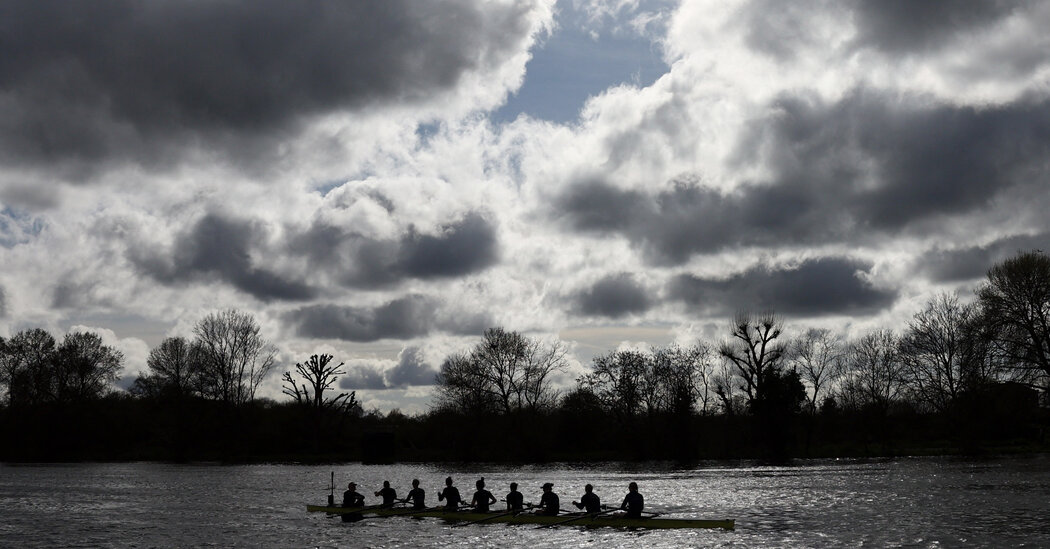The warning was stern: Do not enter the water. Not because of the tide. Not because of sharks. Because of the sewage.
For almost two centuries, rowers from Oxford University have raced their rivals from Cambridge in a contest that typically ends with jubilant members of the victorious crew jumping into the River Thames in celebration.
This year they will be staying as dry as possible.
After the discovery of elevated levels of E. coli in the river, rowers have been urged to stay out of the water, to cover any open wounds and to wash themselves down at a dedicated cleansing station at the finish.
The warning from organizers of the annual competition known as the Boat Race is the most striking symbol of the dire and deteriorating state of Britain’s rivers and coastlines. E. coli, which can be contracted from inadequately treated water supplies, can cause a number of symptoms including diarrhea, stomach cramps and occasionally fever. According to Britain’s health service, a small number of people can also develop hemolytic uraemic syndrome which can sometimes lead to kidney failure and death.
In recent years, England’s private water companies have faced fierce criticism for discharging sewerage and untreated rainwater into waterways and onto beaches when rainfall is heavy — a tactic they use to prevent the system from backing up.
Water firms in England were privatized in 1989, and critics accuse them of paying out huge sums in dividends to their shareholders while failing to make vital infrastructure investments.
While campaigners have long highlighted the problem with water quality, few Britons will have expected contamination to impact the Boat Race, a fixture of the sporting calendar which attracts up to 250,000 spectators as well as a TV audience of millions, organizers say.
Rowers from the two ancient universities will compete over the 4.25-mile course on the Thames on Saturday afternoon, the 169th men’s and 78th women’s races.
The first Boat Race took place on 10 June 1829 at Henley-on-Thames, west of London, and was won by Oxford. However, for the next 25 years, contests happened irregularly and, from 1836, in the national capital. They became annual events in 1856. A women’s boat race was introduced in 1927 but only took place intermittently until the mid-1960s.
The new guidance follows testing of the Thames by River Action, a charity that campaigns for cleaner waterways and said that its tests revealed levels of E. coli up to 10 times higher than the minimum accepted standards for bathing water.
The testing locations suggested that the source of pollution was from Thames Water, the local water company, “discharging sewage directly into the river and its tributaries,” River Action said in a statement.
“We are in a tragic situation when elite athletes are issued with health guidance ahead of a historic race on the capital’s river,” said James Wallace, chief executive officer of River Action. “Our water quality results show what happens after decades of neglect by an unregulated water company, Thames Water.”
The Boat Race, a company that puts on the race and was set up by the Oxford and Cambridge Rowing Foundation, said that it “and the universities involved love rowing on the Thames,” but that “water quality is an ongoing concern.”
In a statement it added: “We have put in place a series of precautionary measures this year to protect the health of our athletes, which includes guidance regarding the covering up of open wounds, regular hand washing, a cleansing station at the finish area and highlighting the risks of entering the water.”
Most of Britain relies on a combined sewer system that pushes both rainwater and human waste along the same set of pipes.
When rainfall is heavy, water firms are sometimes permitted to discharge some of this into rivers or the sea to avoid the pipes being overwhelmed, something that could cause sewage to back up and flood roads and homes.
Critics accuse the water firms of spilling sewage even in dry weather and, according to figures released on Wednesday, last year there were on average 1,271 spills a day across England, compared with 825 in 2022.
In a statement, Thames Water, the utility that is responsible, blamed “higher than average long-term rainfall across London and the Thames Valley.” It said overflows were designed to operate automatically when the sewer network was about to be overwhelmed, so that diluted wastewater would be released into rivers instead of flowing “back up into people’s homes.”
The company added that it was “working hard to make these discharges unnecessary” and had announced plans to upgrade one sewage treatment plant, in southwest London, “to treat the high volumes of incoming sewage and reduce the need for overflows during wet weather.”
That may be of little comfort to this year’s rowers who know that, even if they take all the precautions advised, history suggests there is no guarantee they can stay out of the Thames.
In 1912 both crews were submerged by bad weather, and the most recent sinking took place in 1984 when the Cambridge men’s boat hit a barge before the race had even started.







